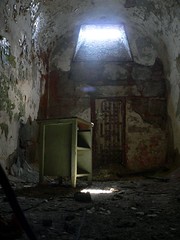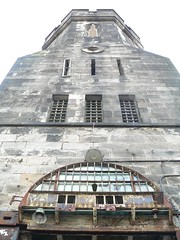
On April 3rd, 1945, 12 men escaped from the Eastern State Pennitentary in Philadelphia. Among them, was the notorius bank robber, "Slick" Willie Sutton. Sutton, as well as the tunnels engineer, Clarence Klinedinst were caught very shortly after the escape. Within 2 days, all then men were back in the prison.
On April 1st, 2006, the tunnel was cleary seen again for the first time in 61 years.

Although, I am late to the game, since this story has been covered by ArchaeologyNews, the AP, NPR, and a slew of newspapers and blog, I figured I should tell my side of the story since it was my companies job to find it.
The story goes, prior to the escape, Clarence Klinedinst, being a mason, was tasked with replastering the walls of cell block 7 (SW arm in this live.com view). After completing this task, he bargained with the officials to give him his choice of cells, he chose cell #68. Incarcerated by him self, he began a project that would take him over a year to complete. Beginning with a specially placed thin plaster wall, which he created during his replastering duty, he began his dig to freedom.
Cell #68 is located at the distal end of  cell block 7, with nothing but 100ft of courtyard, and a 30 foot wall between it and the outside. Clarence Klinedinst (aka Kliney), began to dig, at first by himself then later with a cell mate, into the wall and straight down to the sand sediment below. Once Kliney was into the wall and through the footer, there were no obstructions until he would encounter the 12 foot deep base of the prison wall.
cell block 7, with nothing but 100ft of courtyard, and a 30 foot wall between it and the outside. Clarence Klinedinst (aka Kliney), began to dig, at first by himself then later with a cell mate, into the wall and straight down to the sand sediment below. Once Kliney was into the wall and through the footer, there were no obstructions until he would encounter the 12 foot deep base of the prison wall.
Digging for close to a year and a half, Kliney and his cell mate alluded suspicion. Taking turns digging at night, one prisoner would sleep while the other dug. Paper Mache heads were constructed to fool the ever watchful guards. At first, the prisoners disposed of the rock and soil in the cell toilet and in the yard. After a number of feet was dug from the tunnel, a brick sewer pipe was encountered and used to discard the dirt.
The tunnel was well planned and equipped with an electrical lighting system and wooden bracing. to help keep its integrity. Heading level across the yard, the tunnel was dug to the base of the outer wall and then dug down ~5 feet to get below the walls footing. At this point, the tunnel was excavated through the water table of an old stream that used to flow across the area, before it received 15 feet of fill to level the prison yard.
This stream was part of the escape undoing. On the morning of April 3rd, Kliney, his cell mate, Slick Willey, and 9 other opportunists made a mad dash through the tunnel and out the tiny exit hole on the corner of 22nd and Fairmount. With clothes wet and muddied from crawling though the water filled depression under the wall, the police had little difficulty following the tracks and capturing the crooks. All were hauled back to jail, and one of
No comments:
Post a Comment